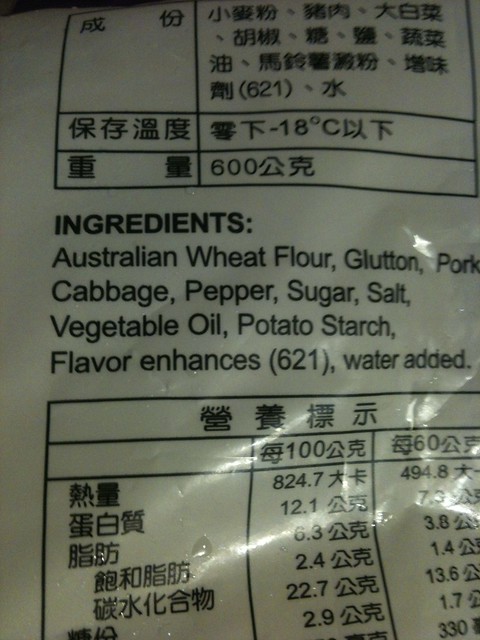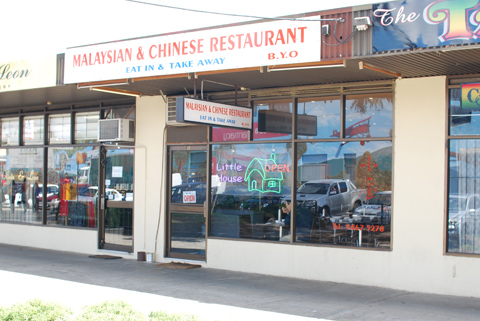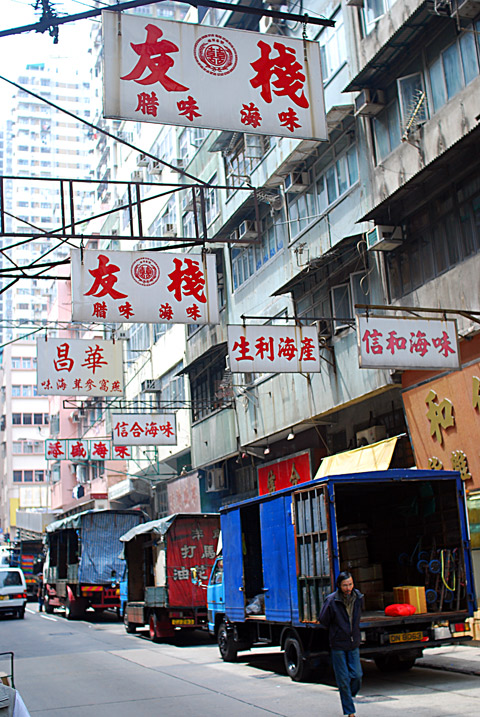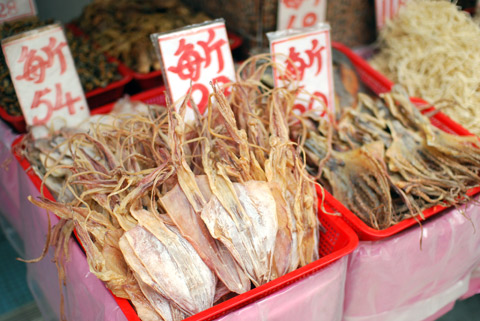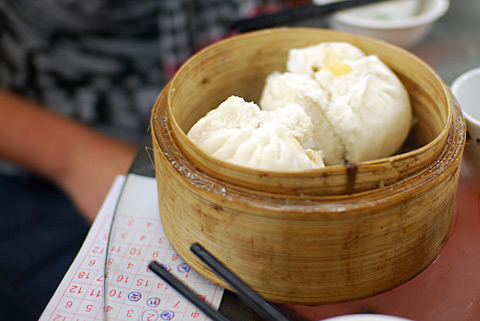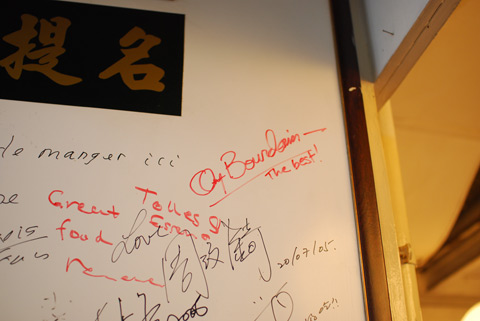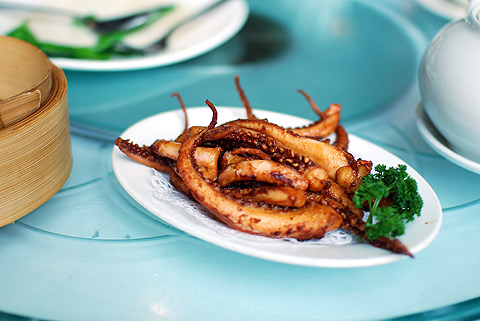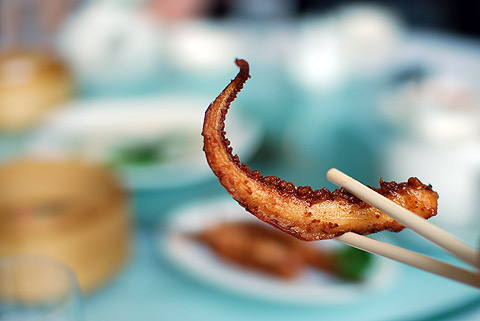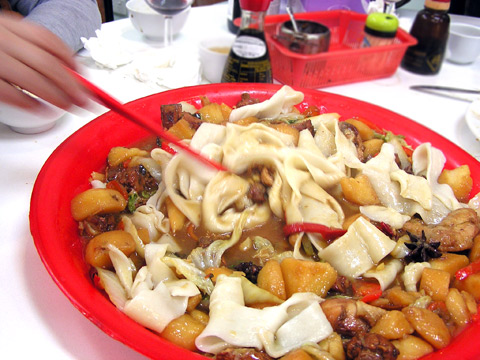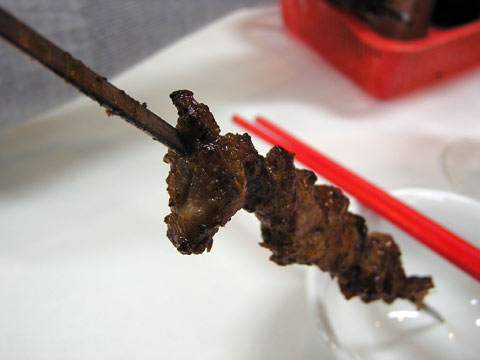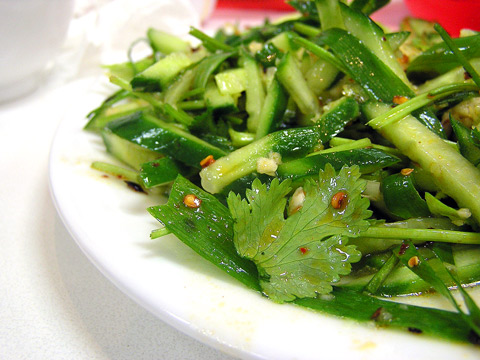Spotted on a packet of pork and cabbage dumplings, Footscray
Posts Tagged → dumplings
Indentured Labour: Camy Shanghai Dumpling House’s secret, part 2
Last time that I mentioned Camy Shanghai Dumpling House, I conjectured that the popularity was due to its open secret status and cheapness. At least now we know where the cheapness comes from: not paying their staff. From the Herald-Sun:
Mr Chang worked 13-hour days from 9.30am-10.30pm with only five-minute breaks, which had to be approved by the boss, for $100 a day.
He worked six days a week and his only holiday was Christmas Day, according to Federal Magistrate Grant Riethmuller. “It is clear that the patrons attended for the quality of the Shanghai dumpling-style cooking rather than the ambience of the premises,” Mr Riethmuller said.
Mr Chang feared if he lost his job his visa would be cancelled and he took action only after he had permanent Australian residency, the magistrate said.
The court found that Mr Chang had been underpaid from December 2004 to January 2008.
Mr Riethmuller ordered restaurant owners Min-Seng Zheng and Rui Zhi Fu to pay $172,677 in unpaid overtime and penalty rates, and $25,000 of superannuation. Their lawyer, Alex Lewenberg, said the owners planned to appeal.
I also praise Federal Magistrate Grant Riethmuller for his knowledge of the premises.
Xiao Long Bao in the Gastrodesert: Little House, Bundoora
I think that it was Australian food writer John Lethlean who labelled the region north of Heidelberg in Melbourne as a gastrodesert. On the surface, it’s gastronomically grim up north; the oleaginous wasteland of charcoal chicken and Smorgy’s. People speak with fondness of shopping mall food courts and premixed bourbon and cola. If Stuff White People Like was written by an Australian white person on unemployment benefits, these are the Likes with which they would Stuff themselves.
Like any desert, the surface appearance is deceptive. There is a whole hidden ecosystem, not as rich as much of Melbourne, but still prepossessing. Witness the above xiao long bao, the Shanghainese soup-filled dumpling that is currently enrapturing well to do Melbournites via the CBD restaurant Hutong. This was to be had in Bundoora, well north of the Heidelberg hinterlands at Little House Restaurant. I’d always thought that the idea of a hidden menu at suburban Chinese restaurants was a racist conceit. Sure, there is the occasional suburban menu where you need to read between the lines of poor translation but my experience is that restaurants put whatever they’re trying to sell at front and centre. The specials board in Mandarin tend to turn up on the menu elsewhere in English. The secrets involve organ meat.
This is not the case at Little House. Xiao long bao appear nowhere on the menu – I’d received a tip from a previously unknown source that these were some of the best dumplings in the state, a claim that I was only going to verify simply because it sounded too ludicrous to carry any truth. Anonymous tipsters paid big bucks in Hong Kong, so why not north of the gastro-divide?
Granted, it is not as good as Hutong’s version – Little House’s xiao long bao has slightly thicker pastry and is not formed with the same delicate hands – but it is a good third cheaper and it fits with the homely appeal of Little House. They are a dumpling that is well above average. Hutong is opposite Melbourne’s best known Cantonese restaurant, Flower Drum. Little House is next to a suburban tattooist run by a man named “Nugget“.
The rest of the menu is modest Shanghainese with a heavy dose of Szechuan – mapo tofu, lamb, chili aplenty. Malaysian is on the sign but barely referred to on the menu, maybe a remnant of a previous owner.
Location: Little House Restaurant, Dennison Mall, Bundoora, Vic
Meandering through Sheung Wan
Just to avoid the impression that I did nothing but eat dumplings in Hong Kong, I also spent a few lazy hours wandering the streets of Sheung Wan in a dumpling and pork induced stupor, planning which dumpling place I’d hit next and remembering dumplings past.
Sheung Wan is where the edible dried miscellany vendors hawk their wares. If you can dry it, someone here sells it as food or medicine. If you need a whole Yunnanese ham, one hundred kilos of fish maw or a bag of assorted turtle plastrons, this is where you will find it. As far as I know, of these three ingredients only one ends up in a dumpling.
Every store has a rich odor of its own, a musty smell that permeates even the passing trams on Des Vouex Road. I find it homely but it is probably not the olfactory overload that most tourists are seeking. You can always head over to the Flower Market Street over in Kowloon.
The surrounding alleyways are packed with small packing houses, distributors and vendors. Porters lug boxes in and out of trucks, and onto low-slung metal trolleys. A few streets specialise in abalone, bird’s nest and ginseng. Judging by the “No Photography” signs on the abalone vendors, I’d wager that a proportion of the abalone is smuggled.
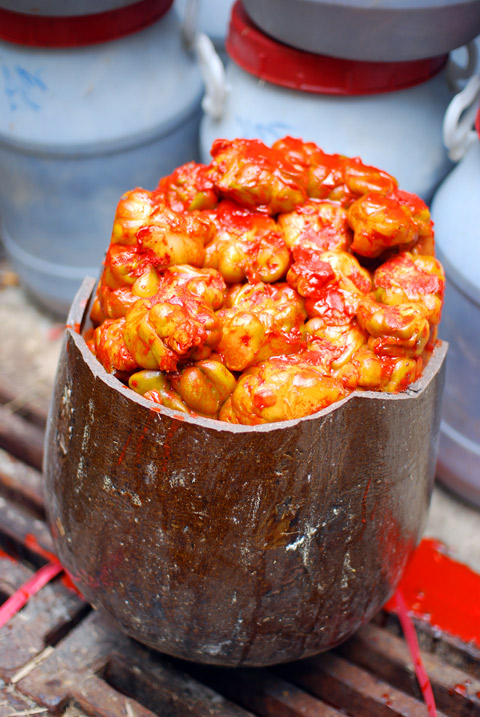
Pickled cabbage vessel, cracked and leaking lurid chili. Not everything stays intact.
Lin Heung, Hong Kong
Lin Heung is proof that the advice from random strangers on the Internet is better than anything published elsewhere. A commenter whom I’ve never seen before mentioned this dim sum joint amongst a handful of the sort of hawker stalls that pique my interest, so I decided to hit it up. Just because I don’t know you does not mean that I don’t trust you.
On a Sunday, Lin Heung is dim sum as competitive sport. Half of the trolleys enter the crowded, windowless room and a mob of ravenous Hong Kongers descend upon it, dim sum chit in hand. There are no clear patterns as to what particular dumplings are most sought after: the crowd seems self reinforcing. Hubbub causes further hubbub. Seating is communal, insofar as there is nowhere else to sit.
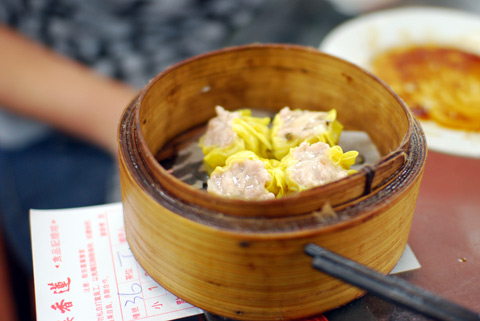
siu mai at Lin Heung, Hong Kong
Everything here surpasses their base ingredients. You can taste the chunks of roughly-cut roast pork in the siu mai.
Their tofu skin is light and barely toothsome; steamed beef balls are as beefy as whichever cut and organs were ground into them. This is the first time that I’ve seen people compete for simple plates of steamed offal. There is none of the premium dumplings; no prawns in anything that I could see. Seafood is on the menu but not off the cart.
The biggest commotion breaks out over their bao; steamed buns. The reason is obvious, the actual bun, normally a neutral and flavourless element is tasty. It tastes like a real bread not simply a indistinct white casing for pork or bean.
It is a very rare occasion that you can find a street vendor or restaurant that is elevating food and doing something greater than selecting the best components at their disposal then cooking them to order. As much as I enjoyed both Lung King Heen and Maxim’s this felt more like home.
Anthony Bourdain gave it his thumbs up. I think that he was onto something.
Location: 162 Wellington Street, Central, Hong Kong
Lung King Heen: 3 star dumplings

Scallop and prawn dumpling, Lung King Heen
It’s a strange thing to live in the bottom half of the planet that has no Michelin stars. In some ways, it has an internal logic for Michelin: the guide’s ostensible purpose was to get people out into the provinces by car and thereby burn through more Michelin rubber. Awarding stars to somewhere that can’t be accessed by automobile does not sell more French tyres. Hong Kong is one hell of a drive from France: it’s a possible but improbable journey, but the stars, they be there.
Maybe Michelin makes tyres for planes these days.
With low-cost carriers now offering flights for roughly the price of buying a beer onboard said plane, I thought that it was about time that I did some serious offshore eating and start collecting stars like a proper, credentialed food critic. Maybe it would convert me to the lifestyle of a high-end eater and my days eating delicious soup in the gutter would be over. I could credibly complain about foie gras and table linen like somebody that works for a serious but doomed print publication.
So I booked in for yum cha at Lung King Heen, Hong Kong’s only three Michelin-starred restaurant. I’m probably not making the most of the experience by eating dim sum but then again, what have I got to prove to anyone? I love dumplings. If I could take the chance at having a meal at the only Cantonese restaurant that Michelin has awarded three stars to, and have them make me a selection of dumplings I would. And did.
Critics probably like writing about serious dining because it gives you much more to write about. Filling a thousand words is easy when you eat twenty courses and you’ve got much more leeway to pick faults when you’re paying a huge bill at the end. They seated me five minutes late. The linen on the table was not perfectly flat. Service is obvious, cookie cutter silver service. English is great. The room is simple: wood panelling; huge windows frame Hong Kong’s harbour which is the “View of the Dragon” to which the restaurant’s name refers. These things are utterly meaningless when it comes to food, but maybe they’re supposed to matter to someone.
Physically, Lung King Heen’s menu has weight and silken texture. Inside, it’s much the same, classic Cantonese dishes subtly tweaked with premium ingredients and new presentation. It is a menu that plays with your memory of other Cantonese food from your past – if you don’t eat much of it, you’d never notice but if you’re an aficionado, I imagine that Lung King Heen’s head chef Chan Yan-tak is permanently winking at you from the kitchen.
There are both vegetarian and organic vegetarian options on the menu which must seem abhorrent to the average Cantonese chef, but if it’s bringing in the stars, maybe it matters. I skipped most of it for the dumplings but ordered roast suckling pig. On with the dumpling porn.
Xiao long bao come served on individual baskets; minimising the chances of puncturing the soup filled dumpling as you extract it from the steamer basket.
The roast suckling pig is presented separated; squares of rich meat topped with a square of pancake and a larger, thin pork skin hat. It’s tough to tackle with chopsticks and keep together in a single bite.
Sesame balls, unexpectedly filled with chunks of roast goose. Scallop dumplings have two whole scallops in them; spring rolls with sea whelk crispness on the outside and gooey interior with chunks of whelk that taste like the fresh sea. The pastry on the beef and morel dumplings tasted like unadulterated butter.
About ten dumplings in, the whole experience reminded me of Maytel from Gut Feeling’s assessment of Thomas Keller’s food:
I know that if I was to put an oyster with a big dolllop of caviar and cover it all in a butter sauce people would probably applaud me too
Top end dining seems to be caught in a self perpetuating cycle – you get lauded by Michelin, you ramp up the use of premium ingredients, you get lauded further. Lung King Heen’s use of luxury ingredients is still restrained and judicious amongst the dumpling menu but it could go awry very quickly.
Does Hong Kong need Michelin’s external validation? The locals already know that they’re onto a good thing and somehow quantifying that experience into a range of zero through three stars seems to do it a grand disservice. I’ve always found anonymous food reviewing somehow dishonest. We all bring our prejudices to the table and stating those prejudices brings out the best in critics; even if that prejudice is unadulterated dumpling love. I’m not looking forward to Michelin stepping south of the equator. We have our own laughable hat system.
Price: ~HK$400 a head
Location: Four Seasons Hotel, Fourth Floor, 8 Finance Street, Central, Hong Kong
Telephone. (852) 3196-8888
Red Emperor, Melbourne
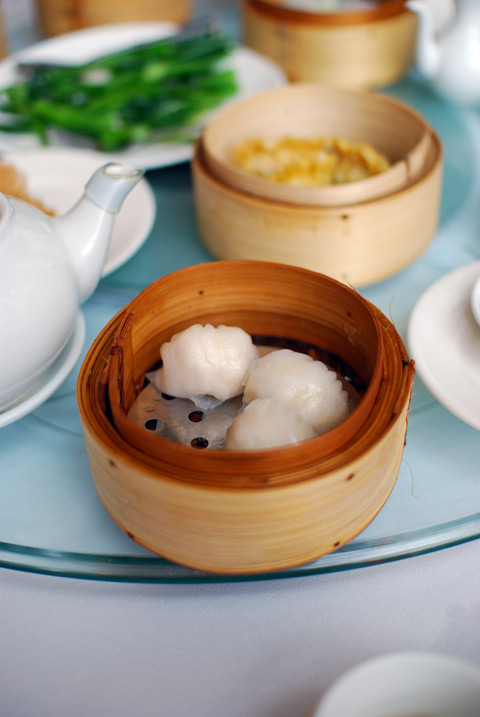
Har gau from Red Emperor, Melbourne
I always thought that only tourists ate on Southbank.
It’s the wrong side of the river for me; that strange cultural divide that bisects Melbourne wherein both sides can say that the other is the morally and culturally wrong side. Since the Casino that dominates the south bank of the Yarra is now taking restaurants more seriously than ever, it is time to reevaluate my prejudices. Southgate, the slightly earlier development on the river still looks like a soulless, polished shopping mall but maybe the food within has changed.
Red Emperor, the Cantonese restaurant within the Southgate complex, is showing its age. The mirrored tiles on the roof, cheap vinyl seats and silver spray-painted concrete columns make the restaurant feel more like a suburban reception centre than one of Melbourne’s leading proponents of Cantonese food (and specifically, yum cha). The superlative view of Flinders Street Station and Melbourne’s skyline from across the Yarra remains unchanged; floor to ceiling windows lend ample distraction from the interior.
Yum cha means “drink tea” in Cantonese. Dim sum is what you eat at yum cha. Yum cha is what you do at Red Emperor. I’ve never ordered much more than a plate of stir-fried gai lan or an extra serve of fried squid from their menu. My guess is that if the gai lan is A$22 a plate, then the rest of their à la carte fare will require me to promise them my first-born in exchange for one of the lobsters crowding their tanks at the entrance.
I’ve never set foot in the place after dark. Lobster before noon is morally reprehensible.
As a midday meal, yum cha is more about the company that you keep than the food itself. It is built to be social: the most memorable yum cha meals should have very little to do with the food. Bamboo steamer baskets filled with mystery dumplings waft by on a trolley for your pleasure, you pick whichever takes your fancy, and then get back to the real task of constructing a conversation. Memorable dumplings help but are not essential.
At least since the last time I’d eaten at Red Emperor, the more interesting items that drift by on the trolley have vanished. The pickles, slices of 100-year old egg, and the cartilaginous steamed chicken’s feet have disappeared. I thought that Melbourne was well past gentrifying its Chinese Food, but in this case, I guess not.
The quality of dumplings – while still good – is only marginally better than you’d receive at one of the mid-range yum cha-focused joints around the CBD, like Westlake, Shark Fin House or Shark Fin Inn. Trekking out to the suburb of Box Hill is even better. At $40-ish a head, you’d get better value elsewhere and charging $8 for tea, normally gratis, is a bitter end to the meal.
Anyhow, on with the short depth of field dumpling porn.

Har gau (North); Random seafood roll (East); “Shark’s Fin” dumpling, not containing actual shark’s fin (South); Siu Mai (West).

Sin Chet Kuen: Beancurd skin rolls stuffed with prawn and shitake mushrooms.
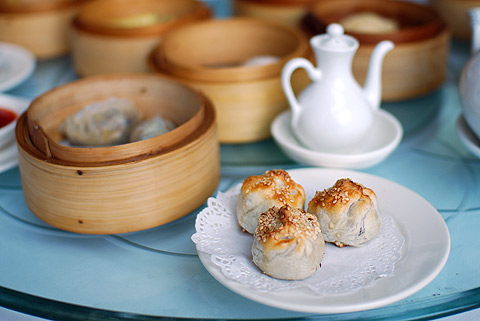
Char Siew Sou: Flaky pastry topped with sesame seeds, filled with sweet red roast pork. My friend J uses these salty-sweet pastries as his yardstick for a good dumpling joint, which makes sense. Both an excellent pastry and top roast pork are hard to achieve, not to mention plating them up to the punters steaming hot.
Location:
Level 3 Southgate,
Southbank, VIC 3006
Tel: (03) 9699-4170
Lunch: Mon – Sat 12 to 3pm, Sun 11 to 4pm
Dinner: 6pm onwards, daily
One-plus-One Dumplings: Uyghur-licious
Chinese food in Australia is for the most part, awful, but it is an awfulness within which you can revel. Steak and black bean sauce, paint-liftingly acidic lemon chicken, your-meat-of-choice stir-fried with cashew nut and cornstarch. Fried rice with peas in it and those little prawns (jumbo krill?) from a can that only exist to populate this specific dish. I still have a lot of love for it, mostly because it represents a resolutely Australian cuisine.
It does bear a passing resemblance to Cantonese food, if you squint hard enough and have a terrible aversion to vegetable matter, offal and real seafood. I’ve been meaning to do some research to uncover Australia’s first Chinese restaurant as a way to find out whom or where gave birth to this food, and why it was Cantonese and not the Uighur food from Western China that captured the Australian palate.
If Central New South Wales had have invented a Chinese cuisine of their own (and been originally populated by nomadic Central Asians subjected to 2500 years of bloody invasion), it would probably look much like Uighur food.
The far Western province of China is built upon sheep and wheat; which the food reflects, as does its location between Tibet, Mongolia, Russia, Afghanistan, Kazakhstan, Kyrgyzstan, Tajikistan, and Pakistan- and India-controlled Kashmir. It thus has a byzantine political history whose richness is only surpassed by its daedal religious intricacy. As a consequence, people eat potatoes; piles of cumin; chili in crazed abundance, both whole dried and as flakes. Fresh wheat noodles are pulled or are presented flattened and hand-cut.
lamb is omnipresent: in the cumin-coated kebabs (above), atop and beneath hot noodles ands soups, providing filling for the dumplings and pastries. Apart from the spices, it couldn’t conform more to the cliche of the Anglo-Australian palate.
Green salads even arrive uncooked and unpreserved which is about as far from the rest of Chinese cuisine as you can possibly veer. Why isn’t this food in every Australian country town?
Apart from the obvious reason that there is no critical mass of Uighur people spread about the countryside, there is probably a Western Chinese restaurant nearby that you wouldn’t otherwise notice unless you could read Chinese characters. One-plus-One Dumplings in Footscray is a case in point. Their name is little more than a ruse to hide their true cuisine; their dumplings only notable for being forgettable; the interior indistinguishable from any other Chinese restaurant under the disinfectant glare of fluorescent lighting and mirror-halled walls.
But the lamb and noodles will transport you straight back to Ürümqi.
While one should eat Uighur food apropos of nothing, this particular occasion to hit up some Western Chinese in the Western suburbs was that Maytel from Gut Feelings was in Melbourne, as were ex-Cambodian expats Andrew and Anth. We are all still bound to upholding the myth that every English language blogger in Cambodia knows each other. And there isn’t a decent Cambodian joint for miles.
Address: One-Plus-One Dumplings, 84 Hopkins St, Footscray
Addendum (27 May 2008): Added Tibet to list of neighbouring nations. I missed it.
